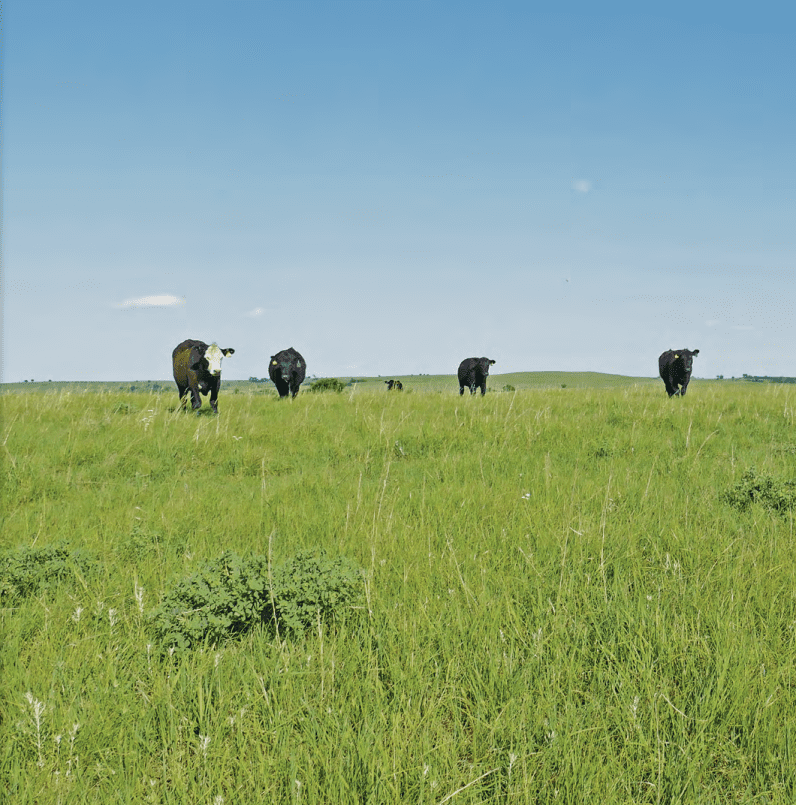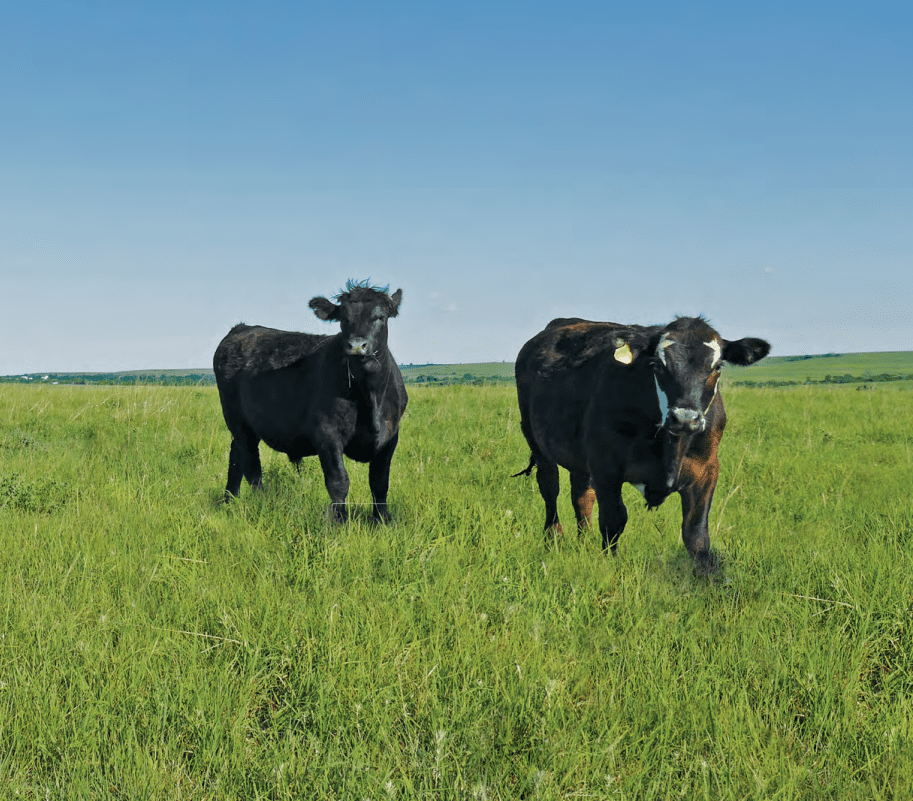

Cattle are ruminant animals, meaning they have a specialized digestive system designed for digesting fibrous plant material efficiently.
The rumen contains microbes that ferment or partially digest feed after it is consumed and plays a crucial role in breaking down complex carbohydrates into nutrients that the animal can absorb and use for growth, milk production and overall health.
Understanding how the rumen functions and the necessity of a balanced diet is essential for maintaining cattle health and maximizing productivity.

The ruminant animal has four compartments located before the small intestine: the rumen, reticulum, omasum and abomasum.
The rumen, often called the “fermentation vat,” is the largest compartment and serves as the primary site for microbial fermentation.
The rumen is home to a diverse population of microorganisms, including bacteria, protozoa and fungi.
These microbes produce enzymes that digest cellulose and hemicellulose, components of plant cell walls that cattle and nonruminants cannot digest on their own.
The fermentation process results in the production of volatile fatty acids, primarily acetate, propionate and butyrate, which serve as the main energy source for the animal and allow cattle to acquire energy from grass or fiber.
Rumen motility is essential for mixing digesta, promoting microbial action and eructating gas produced during ruminal fermentation.
Cattle regurgitate and rechew their food, a process known as cud chewing, to reduce particle size and enhance microbial access to feedstuff substrates.
Rechewing increases saliva production and adds bicarbonate that is present in saliva.
Bicarbonate acts as a buffer in the rumen to help neutralize ruminal pH or the acids being naturally produced by the microbes during fermentation.
The rumen operates optimally at a pH range of 6.0 to 6.8.
If ruminal pH drops below 5.6 due to excessive fermentation of rapidly fermentable carbohydrates, such as starches from grains, acidosis can occur.
Acidosis can lead to reduced appetite, reduced fiber digestion, bloat, diarrhea and, in severe cases, death.

The reticulum and omasum have less impact on digestion but assist with moving feed through the tract to the true stomach, the abomasum.
The abomasum is similar to monogastric stomachs in that acid is produced to begin the chemical breakdown of feed before it enters the intestines.
The intestines are where cattle digest protein and remaining energy from the diet.
Cattle get a large portion of their protein requirement from digesting microbes that were growing and multiplying in the rumen.
Cattle can flourish on high-forage diets because of the energy released by microbes during fermentation and the protein that cattle digest in the form of microbes in the intestine.
Cattle have an additional opportunity to accrue energy from fiber that is digested in the large intestine, similar to other livestock species.
There are subtle differences between cattle and other livestock in the enzymes that are produced during digestion, but in general, the intestinal tract is very similar to nonruminants in design.
Formulating diets that provide energy, protein, minerals and vitamins is important for maintaining rumen function and ensuring proper growth, reproduction and milk production in cattle.
A well-formulated diet provides the necessary nutrients in appropriate proportions.
Water is the most essential nutrient for life, and cattle performance and productivity hinge on access to clean and adequate water.
Water intake drives dry matter intake. The general recommendation for water is 1 to 2 gallons per 100 pounds of body weight but increases during heat stress events.
During winter conditions, cattle require 5 gallons per day, and that can increase to 10 gallons per day during summer conditions.
Energy is a critical dietary component for cattle, especially in high-production animals like feedlot finishing cattle or dairy cows.
Energy comes from carbohydrates like fiber and starch, which are fermented into volatile fatty acids, or can be provided by fat or oil.
Grains that are high in starch, such as corn or wheat, ferment rapidly in the rumen and provide a quick source of energy for the animal.
Forages such as corn silage, alfalfa, grass or crop residues may provide adequate energy for growing calves or cows, although the cost on an energy basis compared to grains is more expensive.
Excessive grain intake can lead to ruminal acidosis and digestive disorders and highlights the importance of managed grain adaptation programs when starting cattle in feedyards.
Even during the feedlot finishing period, providing a minimal amount of forage helps maintain rumination, rumen pH and minimizes risk for acidosis.
The inclusion of forage can vary depending on fiber content of the forage, and in general, providing 5 to 7% fiber from roughage on a dry matter basis in the diet can reduce opportunity for ruminal upset.
Fiber, primarily from forages like hay, silage and pasture grasses, is essential for stimulating rumen activity and maintaining rumen pH.

Feedstuffs and supplements contain varying levels of crude protein.
Crude protein can be broken down into rumen degradable protein, which supports microbial growth and fermentation, and rumen undegradable protein, referred to as a bypass protein as it bypasses the rumen and is absorbed in the intestines for direct animal use.
In general, roughages are higher in rumen degradable protein content, and grains and distillers grains are higher in rumen undegradable protein content.
Supplying adequate rumen undegradable protein to younger and growing animals is critical for muscle development.
Essential minerals and vitamins support numerous physiological functions, including digestion, reproduction and immune system health.
Macrominerals refer to any mineral that is fed in gram quantities or as a percent of diet dry matter, and microminerals refer to minerals fed in milligram or parts per million quantities.
Mineral and vitamin requirements vary based on stage of production and feedstuffs offered to the animal.
Macrominerals critical for cattle include calcium, phosphorus, potassium, magnesium, sodium and sulfur.
Microminerals critical for cattle and vital for enzyme function and metabolic processes include copper, zinc, selenium and iodine.
Vitamins A and E must be provided in the diet for cattle housed outside, and vitamin D is commonly provided in diets as well.
The rumen microbes can synthesize water-soluble vitamins, including B vitamins, vitamin C and vitamin K.
Cattle nutritional needs vary based on their production stage:
• Growing calves: Require high-protein diets to support muscle and bone development.
• Lactating cows: Need increased energy and protein to sustain milk production.
• Finishing cattle: Require energy-dense diets for rapid weight gain, but a careful balance of roughage and fiber is necessary to prevent acidosis.
• Dry cows: Should receive maintenance diets with controlled energy levels to prevent excessive fat accumulation before calving.

Failure to provide a balanced diet can lead to numerous health issues, including:
• Acidosis: Resulting from excessive grain intake and low fiber.
• Bloat: Caused by the buildup of gas in the rumen due to diet imbalances.
• Ketosis: Occurs in lactating cows due to insufficient energy intake.
• Poor growth and reproductive issues: Resulting from protein or mineral deficiencies.
Understanding how the rumen functions and the importance of a balanced diet in cattle is crucial for optimizing health and productivity.
The rumen’s microbial ecosystem relies on a steady supply of water, energy, protein, fiber and minerals to function effectively.
By maintaining a balanced diet that meets the nutritional requirements of cattle at different life stages, producers can ensure higher productivity and improved herd health.
Proper nutrition not only benefits the animals but also enhances profitability and sustainability in livestock production.
 Dr. Jessica Sperber was raised on her family’s 4th generation cow-calf and grain operation located in Alberta, Canada. Jessica attained her master’s degree from West Texas A&M University specialized in meat science, and Ph.D. in feedlot nutrition from the University of Nebraska-Lincoln. Jessica joined the Department of Animal Science at UNL in November of 2022 as an Extension Assistant Professor and Feedlot Specialist. Her areas of interest include nutritional management strategies, technologies that improve cattle production efficiency, and carcass changes over the feeding period.
Dr. Jessica Sperber was raised on her family’s 4th generation cow-calf and grain operation located in Alberta, Canada. Jessica attained her master’s degree from West Texas A&M University specialized in meat science, and Ph.D. in feedlot nutrition from the University of Nebraska-Lincoln. Jessica joined the Department of Animal Science at UNL in November of 2022 as an Extension Assistant Professor and Feedlot Specialist. Her areas of interest include nutritional management strategies, technologies that improve cattle production efficiency, and carcass changes over the feeding period.
 Dr. Galen Erickson holds the Nebraska Cattle Industry Professor of Animal Science professorship in the Department of Animal Science at the University of Nebraska Lincoln and is a Professor and Beef Feedlot Extension Specialist. Research and extension activities focus on beef cattle production and nutrition, particularly cattle nutrition of growing and fattening beef cattle.
Dr. Galen Erickson holds the Nebraska Cattle Industry Professor of Animal Science professorship in the Department of Animal Science at the University of Nebraska Lincoln and is a Professor and Beef Feedlot Extension Specialist. Research and extension activities focus on beef cattle production and nutrition, particularly cattle nutrition of growing and fattening beef cattle.
Get all Doc Talk episodes straight to your email inbox!